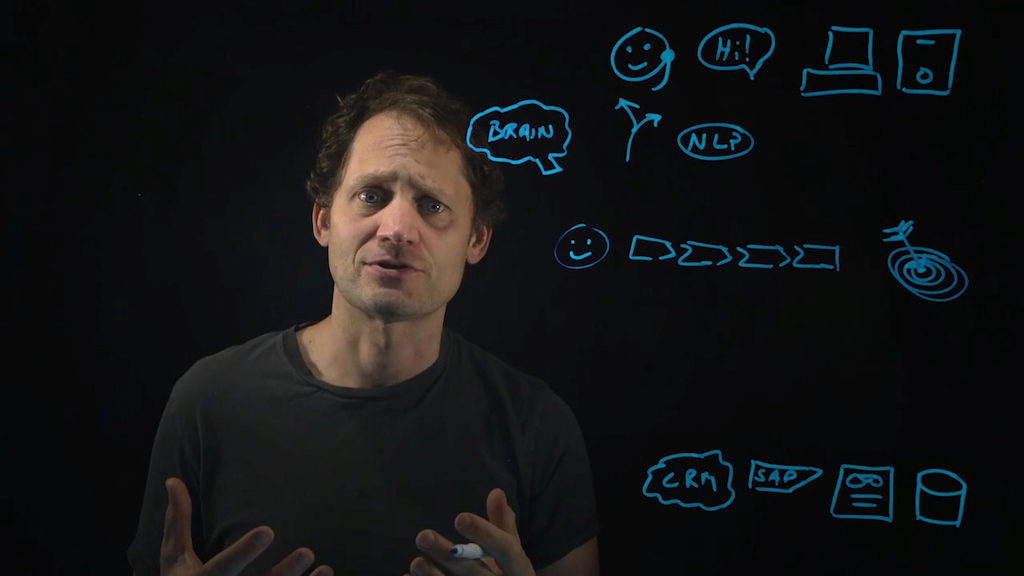
Whiteboard | 04:54
Center-out: You've got to have a brain

Offering the right solution at the right time takes intelligence. Watch Don Schuerman explain how Center-out® business architecture uses a centralized, AI-powered "brain" to inform next-best actions that meet customer needs and empower agents – no matter when, where, or how a journey begins.
This is part 2 of the "Building a business architecture" video series. Watch part 2a: “The different forms and uses of the “brain.”
Transcript:
When you approach your business architecture from the center out, it means you avoid the mistakes of hard coding logic into each of your channels, creating disconnected experiences that are hard and expensive to change. It also means you avoid the mistake of starting at the bottom, trying to contort your product-centric systems and databases to reflect a customer journey that they really aren't agile enough to support.
Instead, a center-out business architecture starts in the center with your customer, most importantly with the outcomes that that customer is trying to achieve, and you map out the journey or what we call the micro journey, the elements of that larger journey that are tied directly to a specific outcome and get a customer there quickly and efficiently.
So how do you build this center-out business architecture? Well, it turns out one of the first things you need is a brain. You need computer intelligence that can operate across all your channels, make the decisions that help you actually satisfy your customer in a proactive, even preemptive way, and ensure that the work gets done efficiently and according to your rules and regulations, and that brain can take different forms. It might guide agents to the best way to troubleshoot a problem or assist a customer. It may consist of NLP, or natural language processing, which is able to take unstructured text, like an email or a document, and categorize it, pull out the customer intent, even pull out pieces of information like a name or an account number. It may take the form of business rules, which are absolutely essential for applying your rules and regulations and assuring that, if you're in a highly regulated industry, you're operating according to those policies, and that brain may take the form of predictive or adaptive analytics.
Predictive analytics is a form of machine learning where humans help mine the data to find patterns so that the system can make decisions. Adaptive analytics is machine learning that's self-learning, that operates on a feedback loop and optimizes over time, and you may pull those two together to drive what we call the next best action.
So how do you figure out in real time, across all channels what's the right conversation to have with a customer? Maybe recommend a new product, maybe help them with service, maybe simply say hello, but what's the action, the next best action that's going to drive the most value, both for the customer and for your business?
Now, in any architecture, you're gonna have multiple places where there's intelligence. There may be intelligence down in your ERP system. There may be some intelligence in your database. Heck, you may have a CRM system that is making batch calculations to figure out potential lifetime value of a customer, but what's important is that you have a brain that acts as the single arbitrator, pulling all that information together, and then going across all your different channels to ensure that, whenever you talk to a customer, you're having a consistent conversation and you're operating in real time based on the latest things that you know about them, and when you can do this, the results are incredible.
Commonwealth Bank of Australia, or CBA, has a customer brain that they've deployed in a center-out architecture across 18 different channels. So that's things like their website, but that's also their branch, their contact center, their mobile app. They use that brain to drive 20 million customer decisions a day, figuring out, in real time, the right action, the right conversation to have, and that has helped them grow their net promoter score, which is sort of a customer satisfaction number, to be 12 points higher than their nearest competitor. That's the incredible result of a center-out business architecture with a brain.
Now, in order for that brain to be really effective, it needs two things. First, it needs context. It needs to understand where the customer is on their particular journey or micro journey, and next, it needs muscle, it needs automation, it needs the ability to get work done, and context and muscle demand case management. So that is what we will talk about next.
Related Resource
Product
App design, revolutionizedOptimize workflow design, fast, with the power of Pega GenAI Blueprint™. Set your vision and see your workflow generated on the spot.
